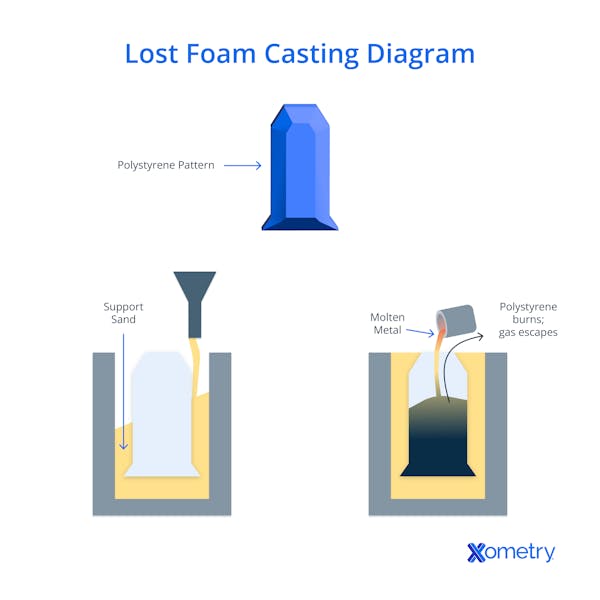How Aluminum Foundry Adds To Innovations in Aerospace Engineering
Aluminum foundries are essential to improvements in aerospace engineering. They create lightweight, high-strength parts that are vital for contemporary airplane. With innovative casting techniques, these shops produce intricate geometries that boost architectural honesty. Additionally, the development of premium Aluminum alloys supports the sector's concentrate on gas efficiency and sustainability. Difficulties remain in the production procedure. Comprehending these elements exposes the extensive impact of Aluminum on air travel's future.
The Importance of Lightweight Products in Aerospace Layout
As the aerospace industry continues to evolve, the significance of lightweight products comes to be progressively noticeable. The demand for effectiveness and sustainability drives designers to focus on using products that decrease total weight without jeopardizing architectural integrity. Light-weight materials, especially Aluminum, play a crucial duty in improving gas performance, boosting payload capacity, and enhancing the total efficiency of airplane.
The integration of these products allows for ingenious layouts, making it possible for suppliers to develop even more aerodynamic shapes that can endure extreme conditions. The reduction in weight not just reduces operational prices yet additionally adds to a lowered ecological impact, straightening with global initiatives toward sustainability in aeronautics.
Advanced Casting Techniques in Aluminum Foundries
Advanced spreading techniques in Aluminum shops play an essential role in aerospace engineering by making it possible for the manufacturing of lightweight and precise parts. Innovations in mold style and accuracy casting processes are essential in attaining ideal efficiency and architectural honesty. Additionally, the development of light-weight alloys boosts the overall efficiency and effectiveness of aerospace applications.
Ingenious Mold Style
Cutting-edge mold layout plays a crucial role in the efficiency and performance of Aluminum shops, especially within the aerospace sector. By leveraging innovative materials and techniques, modern-day molds can be crafted to stand up to heats and pressures, making certain peak efficiency during the casting process. These designs frequently incorporate complex geometries that enable the manufacturing of light-weight yet structurally sound parts, important for aerospace applications. In addition, making use of computer-aided design (CAD) software program facilitates exact modeling, enabling factories to simulate and fine-tune mold layouts before physical manufacturing begins. This not only enhances the high quality of cast parts but also reduces waste and lead times, causing significant cost financial savings. Overall, cutting-edge mold and mildew style is a cornerstone of progress in Aluminum Foundry modern technology for aerospace engineering.
Precision Casting Processes
The efficiency of ingenious mold layouts perfectly incorporates with precision casting procedures, which are vital for creating high-grade Aluminum parts in aerospace engineering. These processes, including sand spreading, die casting, and investment casting, ensure the development of intricate geometries with limited resistances. Advanced strategies like vacuum cleaner spreading and stress die casting improve the integrity and surface coating of the final items. Accuracy casting reduces product waste while taking full advantage of the mechanical homes of Aluminum, important for aerospace applications. In enhancement, utilizing real-time monitoring and progressed simulation devices throughout the spreading process enables immediate adjustments, resulting in enhanced quality control. Collectively, these accuracy spreading procedures placement Aluminum shops at the center of aerospace innovation, sustaining the sector's need for dependability and performance.
Light-weight Alloy Advancement
As aerospace engineers look for to improve fuel efficiency and efficiency, lightweight alloy development becomes an important emphasis in Aluminum foundries. These shops use innovative spreading methods to develop alloys that give superior strength-to-weight ratios. Technologies in alloy composition, consisting of the incorporation of aspects like lithium and magnesium, make it possible for the production of products that endure extreme problems while minimizing overall aircraft weight. Strategies such as die casting and investment casting facilitate the precision production of complex shapes, which are critical for aerospace applications. Additionally, ongoing research study intends to optimize these alloys for boosted mechanical residential properties and enhanced resilience. By focusing on lightweight alloy advancement, Aluminum foundries substantially add to the advancement of aerospace engineering, leading the way for more sustainable and effective airplane designs.

Enhancing Architectural Integrity Via Aluminum Parts
Aluminum elements use significant advantages in improving architectural honesty within aerospace design. Their light-weight nature adds to total performance while preserving toughness, which is important for aircraft performance. Additionally, the tension resistance properties of Aluminum aid assure the resilience and dependability of aerospace structures under various operational problems.
Light-weight Product Benefits
While typical materials typically jeopardize weight for stamina, utilizing Aluminum components in aerospace design supplies considerable advantages in structural integrity. Aluminum's lightweight nature contributes to general layout performance, permitting for more streamlined airplane that eat much less fuel, thereby improving sustainability. The material's superb strength-to-weight ratio warranties that components keep longevity without including unneeded mass. This top quality promotes improved efficiency and agility in trip, in addition to optimized haul abilities. Furthermore, Aluminum's resistance to corrosion lengthens the life expectancy of aerospace frameworks, decreasing upkeep expenses and enhancing safety and security. As producers increasingly adopt Aluminum alloys, the aerospace sector experiences a transformative shift in the direction of more reliable and effective engineering services that prioritize both efficiency and environmental duty.
Anxiety Resistance Properties
Although numerous materials possess special buildings, Aluminum's outstanding tension resistance stands apart as an essential consider enhancing the architectural stability of aerospace components. This resistance plays a crucial function in making sure that airplane can withstand different operational tensions, consisting of exhaustion, influence, and environmental conditions. Aluminum alloys, especially engineered for aerospace applications, display high tensile strength while maintaining light-weight qualities, allowing designers to create a lot more reliable frameworks - Aluminum Foundry. Additionally, the ability of Aluminum to endure cyclic loading without significant contortion adds to the durability and dependability of aerospace parts. As innovations continue in Aluminum Foundry techniques, the growth of stress-resistant Aluminum elements guarantees further improvements in performance, safety and security, and performance across the aerospace market, solidifying Aluminum's duty as a recommended product in contemporary engineering
Gas Performance Improvements Driven by Aluminum Innovations
As the aerospace market seeks to enhance gas effectiveness, ingenious uses of Aluminum have emerged as a crucial option. Aluminum's lightweight nature especially lowers airplane weight, allowing for reduced fuel consumption during trip. This decrease in weight is vital, as even small decreases can lead to considerable improvements in general gas economic situation.
Advanced Aluminum alloys, created for enhanced toughness and durability, make it possible for makers to create elements that maintain structural stability while reducing mass - Aluminum Foundry. Furthermore, the integration of Aluminum in airframes and engine parts helps with boosted aerodynamics, adding to decreased drag and increased effectiveness
The adoption of Aluminum in aerospace not just satisfies the demand for fuel-efficient layout but also aligns with regulatory pressures for reduced emissions. As these advancements remain to progress, they play a substantial duty in establishing brand-new benchmarks for gas efficiency, guaranteeing that the aerospace field can fulfill expanding environmental and financial challenges.

The Role of Aluminum in Sustainable Air Travel Practices
The increasing emphasis on sustainable aeronautics practices has placed Aluminum as a crucial material in the pursuit for greener aircraft style. Understood for its light-weight residential properties, Aluminum significantly decreases aircraft weight, resulting in lower fuel usage and discharges. Its recyclability even more improves its sustainability profile, as Aluminum can be reused forever without loss of top quality. This particular sustains a round economic climate within the aeronautics sector, lessening waste and source depletion.
Innovations in Aluminum alloys have improved their stamina and deterioration resistance, allowing for longer solution life and lowered upkeep requirements. These advancements help with the development of a lot more reliable airplane structures, adding to next general sustainability initiatives. Furthermore, Aluminum's thermal conductivity plays an important duty in energy-efficient styles, boosting systems such as warm exchangers. Jointly, these features underscore Aluminum's crucial function beforehand sustainable aeronautics, lining up with international efforts targeted at reducing the ecological impact of air travel.
Difficulties Faced by Aluminum Foundries in Aerospace Manufacturing
While Aluminum foundries play an essential function in aerospace production, they face substantial difficulties that can impact manufacturing performance and high quality. One major obstacle is the stringent quality assurance standards required in the aerospace industry. Any kind of issue can endanger security and efficiency, demanding extensive inspection processes that prolong manufacturing timelines. Furthermore, foundries typically contend with changing raw product prices, which can affect prices and success. The complexity of Aluminum alloys made use of in aerospace applications additional makes complex the production process, as accurate formulas are essential for achieving wanted mechanical residential properties. In addition, skilled labor lacks hinder the capacity to keep top quality production levels. Ecological guidelines impose restrictions on emissions and waste monitoring, calling for factories to look what i found invest in sustainable techniques, which can be cost-prohibitive. These variables jointly produce a landscape where Aluminum factories should constantly adapt to fulfill the evolving needs of aerospace production while making certain security and compliance.
Future Trends in Aluminum Applications for Aerospace Design
With improvements in innovation and enhancing needs for efficiency, the future of Aluminum applications in aerospace engineering is poised for substantial improvement. The integration of cutting-edge Aluminum alloys and compounds is expected to boost strength-to-weight ratios, leading to even more fuel-efficient aircraft layouts. In addition, developments in additive manufacturing techniques will certainly enable the manufacturing of complicated Aluminum frameworks that were previously difficult, optimizing efficiency and reducing waste.

Lasting practices will play a necessary role, with an expanding emphasis on reusing Aluminum to minimize environmental effect. The aerospace industry is most likely to welcome smarter manufacturing processes, such as automation and man-made intelligence, making certain better and accuracy in Aluminum components. Collaborations between Aluminum foundries and aerospace companies will certainly cultivate study and growth, leading the method for brand-new applications that satisfy the rigid needs of modern-day aerospace design. In general, the future looks guaranteeing for Aluminum's role in shaping the skies
Frequently Asked Concerns
What Are the Environmental Impacts of Aluminum Manufacturing in Aerospace?
The ecological effects of Aluminum production in aerospace include considerable power intake, greenhouse gas emissions, and habitat interruption. Furthermore, mining procedures can cause dirt destruction and water contamination, increasing problems regarding sustainability and environmental balance.
Just How Does Aluminum Contrast to Other Products in Aerospace Applications?
Aluminum provides an one-of-a-kind combination of lightweight properties, deterioration resistance, and cost-effectiveness compared to various other materials. Its high strength-to-weight proportion makes it specifically helpful for aerospace applications, improving gas performance and total efficiency in airplane layout.
What Certifications Do Aluminum Foundry Employees Demand for Aerospace Projects?
Aluminum Foundry employees need specialized training in metallurgy and casting strategies, in addition to knowledge of aerospace sector criteria. Accreditations in quality assurance and security methods are additionally important to assure compliance with strict aerospace project needs.
Are There Any Safety And Security Worry About Making Use Of Aluminum in Aerospace Engineering?
Safety worries pertaining to Aluminum in aerospace design include susceptibility to exhaustion, corrosion, and anxiety fractures. Correct therapy and alloy option are vital to reduce these dangers, ensuring structural stability and total safety in aerospace applications.
Exactly How Does Aluminum Recycling Advantage the Aerospace Industry?
Aluminum recycling greatly profits the aerospace industry by minimizing product expenses, lessening ecological effect, and conserving power. This sustainable method improves about his the market's efficiency while promoting the use of lightweight, high-performance components in aircraft manufacturing.
Advanced spreading strategies in Aluminum shops play a vital function in aerospace engineering by enabling the manufacturing of exact and lightweight components. Innovative mold layout plays an essential duty in the efficiency and performance of Aluminum shops, especially within the aerospace market. As aerospace designers look for to improve gas efficiency and efficiency, light-weight alloy development becomes an important focus in Aluminum shops. Aluminum alloys, particularly engineered for aerospace applications, exhibit high tensile strength while keeping light-weight features, enabling designers to develop more reliable structures. Collaborations in between Aluminum factories and aerospace firms will certainly foster research and growth, leading the way for brand-new applications that meet the rigorous requirements of modern-day aerospace engineering.